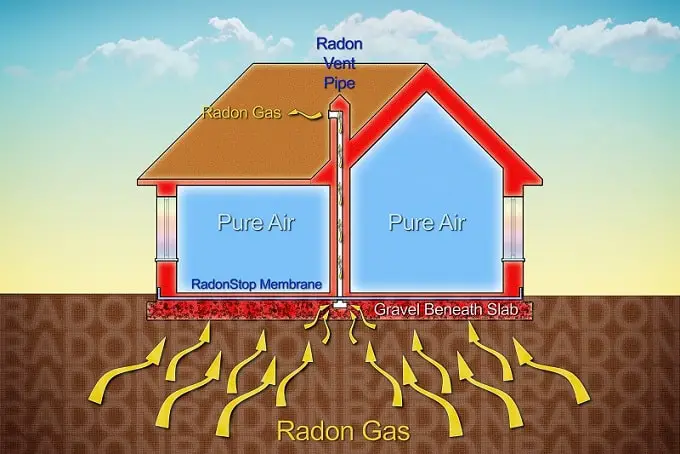You may have heard that radon can be found in homes and that it can be harmful to your health. How do you know if you have radon in your home? What does radon smell like?
Radon does not have a smell. It is an odorless, tasteless, and colorless gas, which makes it much more hazardous to you and your house. Only radon tests tailored specifically for your property can provide an accurate assessment of the amount of radon gas present in your home.

Radon forms when radium in the soil decays into radon. The radium then causes the radon to decay into smaller elements over time.
Before it releases from the ground, radon can accumulate inside buildings, especially buildings with basements or crawl spaces.
What makes this especially alarming is that you cannot smell, taste, or see radon.
In the United States, radon poisoning is the primary cause of lung cancer mortality among nonsmokers.
Furthermore, according to the Surgeon General, radon exposure is the second largest cause of lung cancer, behind cigarette smoking.
Smoking increases your risk of lung cancer by ten times if you reside in a home with high radon levels.
Radon gas is undetectable since it is colorless, odorless, and tasteless, and it causes no discomfort to the eyes or nose.
Radon may build up to dangerous levels within your house if it goes unchecked. The EPA has determined a safe limit of radon exposure at 4 pCi/L. (picocuries per liter of air).
Long-term exposure at this level or above is a substantial risk factor for lung cancer development.
Where is Radon Most Commonly Found?
Now that we understand the dangers of radon, let’s learn more about detecting radon so that we can mitigate this toxic gas. Where is radon most commonly found?
Radon is most commonly found in basements, cellars, and living spaces in contact with the ground. The toxic gas creeps into microscopic fractures in concrete floors and walls, accumulating in any available low-lying space. To eliminate radon gas from these regions, radon mitigation technologies are used.
The majority of people’s radon exposure happens at home, where they spend most of their time, while indoor workplaces can also be a source of exposure.
The amount of radon in a structure is determined by:
- The geology of the area, such as the amount of uranium present and the permeability of the underlying rocks and soils;
- The channels available for radon to flow from the earth into the structure;
- radon emanation from construction materials; and
- The rate of exchange between internal and exterior air is determined by the building’s architecture, residents’ ventilation patterns, and the building’s airtightness.
Radon concentrations differ significantly between buildings, as well as inside a building, from day to day and hour to hour.
Because of these variations, it’s best to determine the yearly mean radon concentration in indoor air by taking measurements for at least three months.
Small passive detectors may be used to assess radon levels in the home in an economical and easy method.
To provide consistency and dependability for decision-making, measurements must be based on national procedures.
Short-term radon tests, performed in accordance with national regulations, might be useful for making judgments in time-sensitive situations, such as when selling a property or evaluating the efficiency of radon mitigation work.
Is it OK to Live in a House with Radon?
With so many homes having varying levels of radon, what do you do? Is it OK to live in a house with radon?
It is OK to live in a house with radon providing cautionary measures are taken to reduce the amount of radon within the home. Radon reduction systems are highly effective at mitigating high levels of radon in a home.
There are ways to protect yourself from radon within a home, so continue reading to learn more about what you can do to take control of your home and the air you breathe.
And if you learn that a home you are considering purchasing has concerning levels of radon, rest assured there are things you can do to mitigate the radon to safer levels.
Depending on the terms of the home-buying contract, the buyer and seller may be required to split the cost of radon mitigation.
If the contract doesn’t specify who pays for mitigation, you can ask the sellers to divide the cost—and they may be prepared to do so to expedite the transaction.
What Are the Symptoms of Radon in Your Home?
Because radon gas is invisible by the five senses of sight, hearing, smell, taste, and touch, it is known as the “silent killer.”
The most reliable approach to determine if you and your family are at risk is to have your house professionally tested for radon gas levels.
According to the EPA, radon gas levels of 4 pCi/L or greater necessitate rapid remedial action to limit radon gas exposure.
When radon levels exceed 4 picocuries per liter (PCi/L), your and your family’s health is jeopardized.
Radon gas penetrates your house or other property from the outside and builds up to harmful levels over time, increasing your risk of lung cancer or other respiratory problems.
Radon gas is deadly, and if the problem isn’t addressed, the radon level in your house will continue to climb.
The Environmental Protection Agency highly advises radon testing, followed by mitigation and treatment if necessary, to protect your safety.
Although there are no signs of radon in your home that can be detected without an actual radon test, there are some physical signs of deteriorating health due to radon damage to the lungs:
- Chest discomfort
- Coughing up blood
- Weight loss
- A persistent cough
- Shortness of breath or wheezing
There are no simple medical tests that can determine whether you’ve inhaled too much radon.
There are no therapies that will remove it from your body. However, if you suspect you’ve been exposed, talk to your doctor about whether you should have testing to see if you’ve developed symptoms of lung cancer.
Can I Test for Radon Myself?
Many of us are do-it-yourselfers and would prefer to test the radon levels in our homes ourselves. So your question might be, can I test for radon myself?
You can easily test for radon yourself by purchasing a radon test kit at your local hardware store or ordering a radon test kit online. At-home radon test kits typically include test vials for sample collecting, as well as a form and a postal address showing where to send your samples for testing.
Short-term radon tests can last for at least 48 hours, whereas long-term radon testing can continue for 90 days or more, depending on your test kit.
After the test has been in your home for a sufficient amount of time, you will submit the sample to the associated lab, where it will be analyzed and the findings sent to you.
There are some things one needs to keep in mind when conducting a radon test.
- Before testing, close all windows and doors leading to the outside as much as possible for at least 12 hours. When you begin your test, close all doors and windows as much as possible, and turn off any fans and air conditioners.
- Place the test in your home’s lowest level. You should do your test on the lowest level of your home, whether it’s a basement or a crawl space.
- Maintain a distance of between 3-5 feet between your radon test kit and the floor.
- Make sure your test kit isn’t disturbed for the specified amount of time, which is normally between 48 and 86 hours.
- Place the test away from vents, windows, and external walls.
- The radon test should not be conducted in a kitchen, utility room, or bathroom. A living room, family room, bedroom, or open unfinished space would be great for your test.
Following these steps helps ensure more accurate radon test results.
Is Testing for Radon Expensive?
When it comes to our health, the cost of testing for radon is worth every dollar. This leads us to a common question, is testing for radon expensive?
The costs to test for radon can range on average between $140 to $850 depending on the size of the home, where the home is located, and how many tests within the home are conducted. Store-bought radon test kit costs range on average between $15 up to $250.
If you plan on purchasing a radon test kit and doing the testing yourself, it’s important to make sure that you have done your research and are using a radon test kit that has a good rating for the best accuracy possible.
Saving a bit of money at the cost of your family’s health can have devasting consequences.
Costs to hire a radon testing professional may rise if you live in a region where the housing market is active.
Inspections are in great demand since they are commonly performed as part of real estate transactions.
For larger homes, some professionals utilize numerous kits, which raises prices.
An inspector’s decision to utilize several kits is influenced by the number of floors and the arrangement of the property, such as if there is a firewall between a garage and a living space.
If your residence is outside of their service radius, some testing businesses may charge a trip fee. For a quotation, contact a radon testing professional in your area.
How Do You Eliminate Radon?
Radon reduction techniques are effective. Some radon mitigation systems can lower your home’s radon levels by up to 99 percent.
The majority of homes may be repaired for the same price as other regular home repairs.
The cost of radon mitigation will vary based on the size and style of your property, as well as the treatments used.
Request a quote from one or more certified radon mitigation companies. Thousands of individuals have successfully lowered radon levels in their homes.
There are a variety of ways to mitigate radon levels in a home, as shown below:
- Suction pipes are introduced through the floor or concrete slab into the concrete slab beneath the residence for sub-slab-depressurization.
The radon gas is then drawn out and released into the atmosphere by a radon vent fan. The most prevalent form of system is this one. - Encapsulating (closing the dirt in a crawlspace with a specific plastic membrane sealed to crawl space foundation walls), then venting using a process similar to that described above.
- A heat recovery ventilator (HRV) or an energy recovery ventilator (ERV) can be used (ERV). An HRV / ERV is a machine that exchanges indoor and outdoor air, lowering radon levels via dilution. My article, What is an Energy Recovery Ventilator (ERV)? Ultimate Resource, goes into much more detail about this effective option.

There are many ways to reduce radon levels in your home. With proper research, a reliable radon test method, and a radon mitigation plan, you and your family can be safe from the deadly effects of radon.
Sources
- Centers for Disease Control and Prevention
- United States Environmental Protection Agency
- American Cancer Society
- Word Health Organization

Trina Greenfield, Author
SmackDown Media LLC
LinkedIn
About the Author:
Trina Greenfield, the owner of SmackDown Media LLC, is passionate about providing information to those interested in the air quality in and around their homes. Trina writes content about things she’s passionate about, such as safe, in-home air, educational platforms for children and adults, as well as all things family-related.